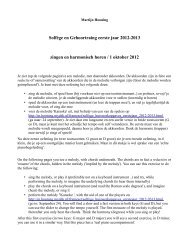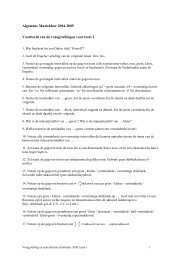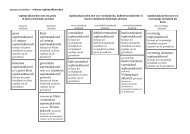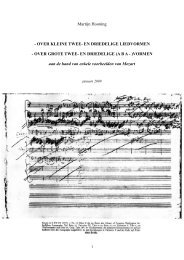Martijn Hooning SOME REMARKS ON SONATA FORM with an ...
Martijn Hooning SOME REMARKS ON SONATA FORM with an ...
Martijn Hooning SOME REMARKS ON SONATA FORM with an ...
Create successful ePaper yourself
Turn your PDF publications into a flip-book with our unique Google optimized e-Paper software.
In this context: note the bass in measures 57/58!<br />
In the consequent motif a' is varied slightly (it is surpassing the first time, from measure 64). And<br />
b ' is naturally is a variation (as the consequent is heading towards a perfect authentic cadence). But<br />
seomthing is going on <strong>with</strong> that very cadence: it fails somewhat... Instead of completing the motion<br />
B – A in measure 68 <strong>with</strong> a G in 69, the upper voice leaps to D (the fifth of the key). And the lower<br />
voice does not do D – D - G (what could be expected in <strong>an</strong> authentic cadence), but D - C – B<br />
instead. For both reasons, we are dealing <strong>with</strong> <strong>an</strong> imperfect authentic cadence here: upper <strong>an</strong>d<br />
lower voice both do not end on the root; the harmony is: I6/4 V2 | I6 (instead of: I6/4 V | I ).<br />
Therefore, the following measures (69-77) are to be considerde as <strong>an</strong> extension of theme 2A: a<br />
group of nine measures, <strong>with</strong> the first measure overlapping <strong>with</strong> the last bar of theme 2A, structered<br />
as: ( 2 + 2 ) + 5<br />
repeat development <strong>an</strong>d close<br />
The real ending of theme 2A is at the end of this extension; we close here <strong>with</strong> a perect authentic<br />
cadence.<br />
After this first cadence in the second group theme 2B is following; the beginning of this theme is<br />
again overlapping. Striking here is above all that we are temporarily continuing in the key of G<br />
minor, the parallel key of G major. The material is clealy derived from the beginning of theme 2A,<br />
which becomes clear when we place the oboe <strong>an</strong>d flute parts of measures 53 <strong>an</strong>d 54 in the same<br />
register:<br />
Clearly visible: in both situations (also) descending fifths are used; only, in theme 2B these are<br />
continuing further: : G → C → F → Bb → Eb . 10 As these notes form the roots of the chords, this<br />
pattern forms a sequence of descending fifths: I IV VII III VI in G minor. (If Beethoven would<br />
continue the sequence II V I would be next, but that s not happening here.)<br />
After this sequence we are heading to the domin<strong>an</strong>t in measure 85 (through a, partly chromatically,<br />
ascending line in the bass!). And then we go back to G major “through the back”: in measure 86 we<br />
reach <strong>an</strong> E minor chord, which is: VI in G major (via (VII7) by the way - <strong>an</strong>d it sounds like a<br />
deceptive cadence).. In this last section of theme 2B we reach a perfect authentic cadence in G<br />
10 Compare <strong>with</strong> the development section!<br />
12






